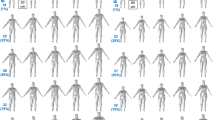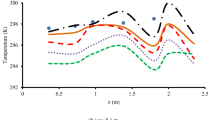Abstract
Predicting human thermal comfort and safety requires quantitative knowledge of the convective heat transfer between the body and its surrounding. So far, convective heat transfer coefficient correlations have been based only upon measurements or simulations of the average body shape of an adult. To address this knowledge gap, here we quantify the impact of adult human body shape on forced convection. To do this, we generated fifty three-dimensional human body meshes covering 1st to 99th percentile variation in height and body mass index (BMI) of the USA adult population. We developed a coupled turbulent flow and convective heat transfer simulation and benchmarked it in the 0.5 to 2.5 m·s−1 air speed range against prior literature. We computed the overall heat transfer coefficients, hoverall, for the manikins for representative airflow with 2 m·s−1 uniform speed and 5% turbulence intensity. We found that hoverall varied only between 19.9 and 23.2 W·m−2 K−1. Within this small range, the height of the manikins had negligible impact while an increase in the BMI led to a nearly linear decrease of the hoverall. Evaluation of the local coefficients revealed that those also nearly linearly decreased with BMI, which correlated to an inversely proportional local area (i.e., cross-sectional dimension) increase. Since even the most considerable difference that exists between 1st and 99th percentile BMI manikins is less than 15% of hoverall of the average manikin, it can be concluded that the impact of the human body shape on the convective heat transfer is minor.





Similar content being viewed by others
Data availability
The manikin models are available on the ASU Dataverse website (dataverse.asu.edu/dataverse/thermal-manikins).
Abbreviations
- \({h}_{overall}\) :
-
Overall heat transfer coefficient, (W·m−vK−v)
- \(\nu\) :
-
Air speed (m·s−1)
- \(BMI\) :
-
Body mass index (kg·m−2)
References
Belghazi K, Elabbassi EB, Tourneux P, Libert J (2005) Assessment of whole body and regional evaporative heat loss coefficients in very premature infants using a thermal mannequin: influence of air velocity. Med Phys 32:752–758
Bergman TL, Lavine AS, Incropera FP, Dewitt DP (2011) Fundamentals of heat and mass transfer. John Wiley & Sons Inc, New York
Coull NA, West AM, Hodder SG et al (2021) Body mapping of regional sweat distribution in young and older males. Eur J Appl Physiol 121:109–125
Daniell N, Fraysse F, Paul G (2012) How does the size and shape of local populations in China compare to general anthropometric surveys currently used for product design? Work 41:4088–4090
Davoudiantalab AHDA, Meshkani M, Nourian S, Mofidi AA (2013) Anthropometric dimensions of Iranian male workers and comparison with three Asian countries. Int J Occup Hyg 5:166–171
de Dear RJ, Arens E, Hui Z, Oguro M (1997) Convective and radiative heat transfer coefficients for individual human body segments. Int J Biometeorol 40:141–156
Defraeye T, Blocken B, Koninckx E et al (2011) Computational fluid dynamics analysis of drag and convective heat transfer of individual body segments for different cyclist positions. J Biomech 44:1695–1701
Dreyfuss H (1993) The measure of man and woman: human factors in design, 2nd edn. Whitney Library of Design, New York
Ebi KL, Capon A, Berry P et al (2021) Hot weather and heat extremes: health risks. Lancet 398:698–708
Ebi KL, Vanos J, Baldwin JW et al (2021) Extreme weather and climate change: population health and health system implications. Annu Rev Public Health 42:293
Elabbassi EB, Chardon K, Bach V et al (2002) Head insulation and heat loss in naked and clothed newborns using a thermal mannequin. Med Phys 29:1090–1096
Fanger PO (1972) Thermal comfort. McGraw-Hill Book Company, New York
Fiala D, Havenith G (2015) Modelling human heat transfer and temperature regulation. The mechanobiology and mechanophysiology of military-related injuries. Springer, Cham, pp 265–302
Fiala D, Lomas KJ, Stohrer M (1999) A computer model of human thermoregulation for a wide range of environmental conditions: the passive system. J Appl Physiol 87(5):1957–1972
Fournet D, Ross L, Voelcker T et al (2013) Body mapping of thermoregulatory and perceptual responses of males and females running in the cold. J Therm Biol 38:339–344
Fromuth RC, Parkinson MB (2008) Predicting 5th and 95th percentile anthropometric segment lengths from population stature. Proceedings of the ASME 2008 Int Des Eng Tech Conf Comput Inf Eng Conf, Brooklyn, NY, pp 581–588
Hannouch A, Habchi C, Lemenand T, Khoury K (2020) Numerical evaluation of the convective and radiative heat transfer coefficients for preterm neonate body segments inside an incubator. Build Environ 183:107085
Haslam RA, Parsons KC (1987) A comparison of models for predicting human response to hot and cold environments. Ergonomics 30:1599–1614
Hilpert R (1933) Heat transfer from cylinders. Forsch Geb Ingenieurwes 4:215
Ichihara M (1997) Measurement of convective and radiative hear transfer coefficients for the standing and sitting human body using a thermal manikin. J Archit Plann Environ Eng, AIJ 501:45–51
Ito K, Hotta T (2006) Development of virtual manikins and its grid library for CFD analysis.Trans Soc Heat, Air Cond Sanitary Eng Japan 113:27–33
Li C, Ito K (2012) Numerical analysis of convective heat and mass transfer around human body under strong wind. Int J High-Rise Build 1:107–116
Lin Y-C, Wang M-JJ, Wang EM (2004) The comparisons of anthropometric characteristics among four peoples in East Asia. Appl Ergon 35:173–178
Mao N, Song M, Pan D, Deng S (2017) Computational fluid dynamics analysis of convective heat transfer coefficients for a sleeping human body. Appl Therm Eng 117:385–396
Martinho N, Lopes A, Silva MCG et al (2007) Human numerical model for evaluation of thermal comfort in vehicles. 1th European Automotive Congress - Automobile for the Futur, Budepest, pp 1–10
Mora C, Dousset B, Caldwell IR et al (2017) Global risk of deadly heat. Nat Clim Chang 7:501–506
Nishi Y, Gagge AP (1970) Direct evaluation of convective heat transfer coefficient by naphthalene sublimation. J Appl Physiol 29:830–838
Oguro M, Arens E, Zhang H, Katayama T (2002) Convective heat transfer coefficients and clothing insulations for parts of the clothed human body under airflow conditions. J Architec Plan 67:21–29
Oliveira AVM, Gaspar AR, Francisco SC, Quintela DA (2014) Analysis of natural and forced convection heat losses from a thermal manikin: comparative assessment of the static and dynamic postures. J Wind Eng Ind Aerodyn 132:66–76
Ono T, Murakami S, Ooka R, Omori T (2008) Numerical and experimental study on convective heat transfer of the human body in the outdoor environment. J Wind Eng Ind Aerodyn 96:1719–1732
Ostrowski Z, Rojczyk M (2018) Natural convection heat transfer coefficient for newborn baby. Heat Mass Transf 54:2395–2403
Parkinsons M (n.d.) Open Design Lab Manikin Fether. http://tools.openlab.psu.edu/tools/fetcher.php. Accessed 22 Mar 2023
Parsons K (2014) Human thermal environments: the effects of hot, moderate, and cold environments on human health, comfort, and performance. CRC Press
Parsons K (2019) Human heat stress. CRC Press
Rykaczewski K, Bartels L, Martinez DM, Viswanathan SH (2022a) Human body radiation area factors for diverse adult population. Int J Biometeorol 66:2357–2367
Rykaczewski K, Bartels L, Martinez DM, Viswanathan SH (2022b) Computational manikin for radiation simulation (male and female models covering 1–99% BMI and height diversity in US. https://doi.org/10.48349/ASU/ZCLKT6. Accessed 22 Mar 2023
Rykaczewski K, Vanos JK, Middel A (2022c) Anisotropic radiation source models for computational thermal manikin simulations based on common radiation field measurements. Build Environ 208:108636
Sarman I, Bolin D, Holmér I, Tunell R (1992) Assessment of thermal conditions in neonatal care: use of a manikin of premature baby size. Am J Perinatol 9:239–246
Vanos JK, Rykaczewski K, Middel A et al (2021) Improved methods for estimating mean radiant temperature in hot and sunny outdoor settings. Int J Biometeorol 65:967–983
Winslow C-E, Ap G, Herrington LP (1939) The influence of air movement upon heat losses from the clothed human body. American Journal of Physiology-Legacy Content 127:505–518
Wissler EH (2018) Human temperature control: a quantitative Approach, 1st edn. Springer, Berlin, Germany
Xu J, Psikuta A, Li J et al (2021a) A numerical investigation of the influence of wind on convective heat transfer from the human body in a ventilated room. Build Environ 188:107427
Xu J, Psikuta A, Li J et al (2019) Influence of human body geometry, posture and the surrounding environment on body heat loss based on a validated numerical model. Build Environ 166:106340
Xu J, Psikuta A, Li J et al (2021b) Evaluation of the convective heat transfer coefficient of human body and its effect on the human thermoregulation predictions. Build Environ 196:107778
Yu Y, Liu J, Chauhan K et al (2020) Experimental study on convective heat transfer coefficients for the human body exposed to turbulent wind conditions. Build Environ 169:106533
Zhang M, Li R, Li J et al (2021a) A 3D multi-segment thermoregulation model of the hand with realistic anatomy: development, validation, and parametric analysis. Build Environ 201:107964
Zhang M, Li R, Wu Y et al (2021b) Numerical study of the convective heat transfer coefficient of the hand and the effect of wind. Build Environ 188:107482
Zhou S, Niu J (2022) Measurement of the convective heat transfer coefficient of the human body in the lift-up design. In: E3S Web of Conferences. EDP Sciences, p 03001
Zou J, Liu J, Niu J, et al (2020) Convective heat loss from computational thermal manikin subject to outdoor wind environments. Build Environ 107469
Acknowledgements
The authors also acknowledge Research Computing at ASU for providing high-performance computing resources that have contributed to the research results reported within this paper.
Funding
This research was supported by the National Science Foundation Leading Engineering for America’s Prosperity, Health, and Infrastructure (LEAP HI) #2152468 award (KR) and Master’s Opportunity for Research in Engineering from Fulton Schools of Engineering at Arizona State University (SHV).
Author information
Authors and Affiliations
Contributions
Conceptualization and methodology: KR, SHV, LB, DMM, and SSG. Analysis: KR and SHV. Writing—original draft: SHV and KR. Writing—review and editing: SHV, and KR. Final review and editing: SHV, KR, LB, DMM, and SSG.
Corresponding author
Ethics declarations
Conflicts of interest
The authors declare no competing interests.
Supplementary Information
Below is the link to the electronic supplementary material.
Rights and permissions
Springer Nature or its licensor (e.g. a society or other partner) holds exclusive rights to this article under a publishing agreement with the author(s) or other rightsholder(s); author self-archiving of the accepted manuscript version of this article is solely governed by the terms of such publishing agreement and applicable law.
About this article
Cite this article
Viswanathan, S.H., Martinez, D.M., Bartels, L. et al. Impact of human body shape on forced convection heat transfer. Int J Biometeorol 67, 865–873 (2023). https://doi.org/10.1007/s00484-023-02461-z
Received:
Revised:
Accepted:
Published:
Issue Date:
DOI: https://doi.org/10.1007/s00484-023-02461-z




